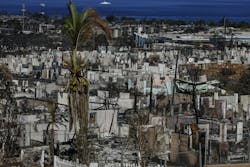Preliminary After-Action Report on Historic Wildfire Released by Maui, HI, Police
"Throughout the fires, the initial aftermath, and until today, the resilience of the community never faltered. The selflessness displayed truly showcased that in the face of adversity, the spirit of aloha not only stands true, but it shines bright."
That observation is included in the Maui Police Department's Prelminary After-Action Report on the Maui wildfres released recently.
The document evaluates the actions of law einforment officers during the historic wildfires last summer that claimed 100 lives.
After investigating the incident from the police prospective, authors made 32 recommendations "to enhance future natural disaster response efforts."
There were numerous issues with communications throughout the incident as officers involved in evacuations or other tasks couldn't hear sometimes vital information. If officers were issued ear pieces, that may solve some of the communications problems, the report showed.
"On investigation, it is evident that there were issues with radio communications at times. These issues included periodic miscommunications. Although these issues are not a rare occurrence in everyday radio communications, they were exacerbated due to a variety of factors that included:
when officers stood outside of their vehicles, they had difficulty communicating and hearing in the high winds (approximately 60 to 80 mph). This led to some misunderstandings of radio transmissions."
Officers also noted that numerous agencies were involved with a myriad of tasks including responsive support with security, traffic control, casualty recoveries, investigation of missing persons, morgue operations, and the Family Assistance Center operations.
Personnel at Emergency Communications Centers were overwhelmed by the number of calls not from people reporting emergencies by a variety of other issues or concerns.
Maui Police Chief John Pelletier developed an organizational chart in
compliance with the Incident Command System (ICS) as directed by Presidential Executive Order which established the National Incident Management System (NIMS).
Officers noted that the Law Enforcement Branch was compliant throughout the operation.
The report discussed the media and information that was being shared on social media.
"The vast media coverage brought the plight of the Maui disaster to the world and resulted in a record number of funds being contributed to the Maui community. The worldwide coverage also assisted in obtaining family DNA reference samples as MPD worked to identify victims," they wrote.
Officers also reached out to the media to dispel rumors and misinformation about the wildfires and aftermath such as remains washing ashore on other islands.
"Now, here we stand, amid destruction and chaos, with an opportunity to write a new story. That story istold through the Maui Strong patch to exemplify the courage in vulnerability and honor the lives of those who were lost and to pay tribute to those left to rebuild. A story for which time will be still."
Recommendations:
1 Have optional radio ear pieces issued to all officers.
2 Create a procedure for call signs for officers that self-deploy during
a critical/large scale incident.
3 Roll calls should be initiated by dispatch and/or command staff as
needed.
4 Have the BWC policy updated to have BWC activated upon
dispatch.
5 Hire a social media manager to cover all aspects of social media,
to report to the department’s PIO.
6 Review and make necessary amendments to General Order 301.2,
and other related general orders, as to create policy and
procedure on administrative notifications during unusual
occurrences, natural disasters, and man-made disasters.
Considering that some situations, such as the one experienced on
August 8, 2023, where means of communications was limited, and
email notifications of officials may not be feasible or available,
may necessitate other means of notifications.
7 ICS training to be provided to all sworn personnel. 100 - 200 by all
PO’s, 300 – 400 by all sergeants and lieutenants, 700 by all
captains and above.
8 All commanders, captains and above receive training on activation
of the DOC and a Department Operations Center quick reference
guide be developed for commanders to be utilized for all crisis.
9 Although there is an annual review, the Natural and Man-made
Disaster Plan, General Order be reviewed and updated following
the incident.
10 All commanders participate in live training exercises in DOC
activation
About the Author
Firehouse.com News
Content curated and written by Firehouse editorial staff, including Susan Nicol, Peter Matthews, Ryan Baker and Rich Dzierwa.
